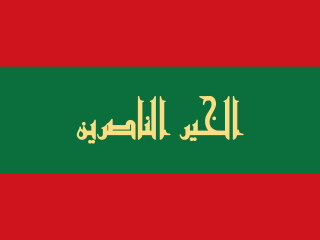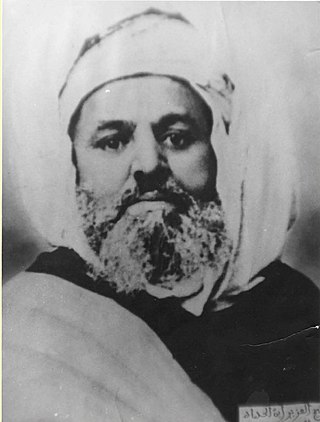
The Regency of Algiers was a largely independent early modern Ottoman tributary state on the Barbary Coast of North Africa between 1516 and 1830. Founded by the privateer brothers Aruj and Hayreddin Barbarossa, also known as Oruç and Khayr ad-Din, the Regency began as an infamous and formidable pirate base that plundered and waged maritime holy war on European Christian powers. Ottoman regents ruled as heads of a stratocracy; an autonomous military government controlled by the janissary corps, themed Garp ocaklarılit. 'Western Garrison' in Ottoman terminology.

Sheikh Mohamed El-Mokrani, also known as Mohand Amokrane, was one of the principal leaders and the namesake of the Mokrani Revolt of 1871 against the French occupation of Algeria.

The invasion of Algiers in 1830 was a large-scale military operation by which the Kingdom of France, ruled by Charles X, invaded and conquered the Deylik of Algiers.

The French conquest of Algeria took place between 1830 and 1903. In 1827, an argument between Hussein Dey, the ruler of the Regency of Algiers, and the French consul escalated into a blockade, following which the July Monarchy of France invaded and quickly seized Algiers in 1830, and seized other coastal communities. Amid internal political strife in France, decisions were repeatedly taken to retain control of the territory, and additional military forces were brought in over the following years to quell resistance in the interior of the country.

Mohamed Bey El Mouradi was a Muradid leader and Bey of Tunis from 1675 until his death in 1696. He was the eldest son of Murad II Bey.

Bou-Nouh is a town and commune in Tizi Ouzou Province in northern Algeria.

Igawawen or Gawawa, mostly known as Zwawa were a group of Kabyle tribes inhabiting the Djurdjura mountains, Greater Kabylia, in Algeria. The Zouaoua are a branch of the Kutama tribe of the Baranis Berbers.

The Kingdom of the Ait Abbas or Sultanate of the Beni Abbas was a Kabyle, Berber state of North Africa, then a fief and a principality, controlling Lesser Kabylie and its surroundings from the sixteenth century to the nineteenth century. It is referred to in the Spanish historiography as "reino de Labes"; sometimes more commonly referred to by its ruling family, the Mokrani, in Berber At Muqran. Its capital was the Kalâa of Ait Abbas, an impregnable citadel in the Biban mountain range.

Battle of Staoueli, was a battle between the Kingdom of France and the Regency of Algiers in western Algiers while France was trying to take control over the capital.

Conflicts between the Regency of Algiers and the Cherifian dynasties or Algerian-Sherifian conflicts opposed Morocco to the Ottoman Empire and its dependencies in a series of wars between the Regency of Algiers and its allied local sultanates and tribal confederations, and on the other hand, the Sharifian Saadian and Alawite dynasties that had ruled Morocco since the 16th century.

The Awlad Sidi Shaykh was a confederation of Arab tribes in the west and south of Algeria led by the descendants of the Sufi saint Sidi Shaykh. The Awlad had religious authority, and also owned agricultural settlements and engaged in trade. During the French occupation of Algeria they alternately cooperated with and opposed the colonialists.

The Mokrani Revolt was the most important local uprising against France in Algeria since the conquest in 1830.
The Battle of Alma or Battle of Boudouaou, which broke out on 19 April 1871, was a battle of the Mokrani Revolt by Algerian rebels against France, which had been the colonial power in the region since 1830.

The Battle of the Col des Beni Aïcha or Battle of Thenia, which broke out on 19 April 1871, was a battle of the Mokrani Revolt between the Algerian rebels, and the France, which was the colonial power in the region since 1830.
Cheikh Mohamed El-Boumerdassi was one of the principal leaders of the popular Mokrani Revolt uprising of 1871 against the French occupation of Algeria.

Zawiyet Sidi Boumerdassi or Zawiyet Ouled Boumerdès is a zawiya located within Boumerdès Province in Algeria.
Zawiyet Sidi Amar Cherif, or Zawiyet Sidi Daoud, is a zawiya school located in Boumerdès Province in Algeria.
Brahim Boushaki was an Algerian Scholar, Imam and Sufi Sheikh. He was born in the village of Soumâa near the town of Thénia 53 km east of Algiers. He was raised in a very spiritual environment within Zawiyet Sidi Boushaki with high Islamic values and ethics. He had great interpersonal skills and devoted his entire life in service of Islam and Algeria according to the Algerian Islamic reference.

The Hafsids of Béjaïa were a dynasty of independent or autonomous emirs. They were a branch of the Hafsid dynasty that ruled from Tunis; at times they recognised the caliph in Tunis and at other times they ruled independently. Periodically there was also conflict between the two branches of the dynasty.

Muhand Amezyan Aheddad, also known as Cheikh El Haddad, was a prominent leader in the 1871 uprising in Algeria. He collaborated closely with Cheikh El Mokrani and Boumezrag El Mokrani during this period.













